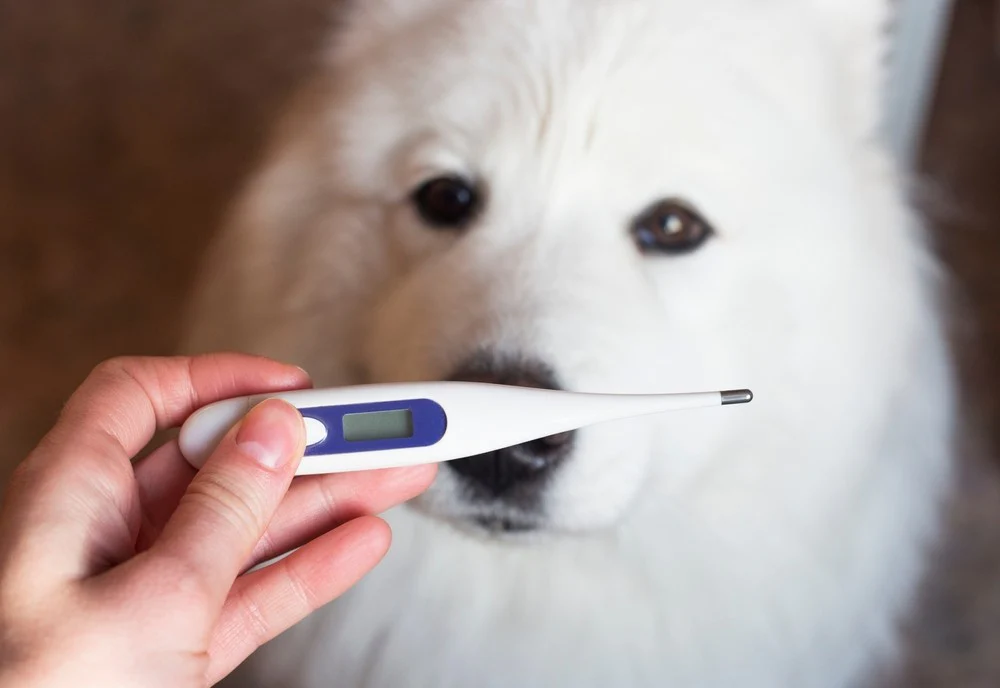
One of the best ways to confirm whether or not your dog has a fever is to use an ear or rectal thermometer to check for a temperature. Do not try to diagnose your dog’s condition by touching its nose to determine whether or not it is hot. You can tell whether your dog has a fever by using a thermometer.
You may be wondering what to do if you accurately determined that your dog has a fever. When you discover your dog has a fever, it may be just as upsetting as finding out one of your children is sick. In this post, we’ll go over what a normal canine body temperature is, how to tell if your dog has a fever, how vets often diagnose fevers, and what kinds of treatments are available.
Where Do Dogs Typically Temperate?
A dog’s usual body temperature is between 99.5 to 102.5 degrees Fahrenheit due to the fact that dogs are inherently warmer animals. When your dog’s temperature rises to 103 degrees Fahrenheit or more, it is quite probable that they are ill with a fever. When their core body temperature reaches 106 degrees or greater, it may cause serious damage to vital organs and even death. You should never allow your dog’s temperature to get beyond 103 degrees Fahrenheit.
If your dog’s fever persists, you should take him to the doctor for treatment. Taking a temperature reading from your dog’s ear or the rectal area will give you the most accurate results. Taking a dog’s temperature is difficult since you have to touch their ears and paws, both of which they may be sensitive about.
Rectal thermometers are the most accurate technique to determine your dog’s temperature, but you must have everything ready ahead of time and the dog must be relaxed. By coating the thermometer’s tip with petroleum jelly or another lubricant, you may make the operation less painful for your dog and reduce the risk of puncturing its delicate skin. After making sure your dog is relaxed, cut a small slit at the end of the thermometer and insert it approximately an inch into the rectum.
The use of an ear thermometer, which is inserted into the ear canal, is an option, albeit it depends on your dog’s personality. The dog’s ear and rectum are safe zones, but you shouldn’t go in too far. Too much thermometer insertion into the ear canal of your dog might cause a rupture.
On the other hand, thermometers might falsely indicate that your dog is running a temperature even if one isn’t there. When a dog gets enthusiastic, its body temperature may rise by a few degrees. Don’t ever take your dog’s temperature if he or she has been exercising or sunbathing. Doing any of these things with your dog may raise his body temperature, which in turn can alter the temperature measurement.
Causes and Symptoms of a Dog’s Fever
Your dog’s body temperature will rise in response to a viral or bacterial illness in an effort to combat the infection. Additionally, a fever may stimulate the immune system, making it simpler for the body to combat whatever is causing the fever. Because fever is an indicator that your dog’s health is declining, it often occurs in tandem with other symptoms1, such as:
- Red eyes
- Lethargy
- Warm ears and nose
- Shivering
- Lack of appetite
- Coughing
- Vomiting
Quite a few of these symptoms point to a more significant medical issue. In the case of dogs, a high temperature coupled with symptoms such as coughing, wheezing, vomiting, and ocular discharge may suggest distemper. Another symptom of poisoning in dogs is a lack of appetite or vomiting in addition to a high temperature. You should have your dog checked out by the vet immediately if it starts having diarrhea and seems sluggish.
Canine Fever: What Can Cause It?
There might be various causes for your dog’s fever. Fever may be caused by your dog eating something poisonous, but it can also be a side effect of immunizations or drugs.
Your dog’s fever might also be caused by a bacterial, fungal, or viral infection, such as:
- Ear infections
- Urinary Tract Infections (UTI)
- Infections due to wounds, bites, or cuts
- Infections due to dental issues
- Infections in a dog’s organs
Dogs may acquire a heat rash on their bellies for a number of reasons, including but not limited to heat poisoning, allergies, or even just being overheated. When dogs have a fever, it’s often because they ingested something poisonous. A dog’s fever might be caused by anything from inflammation to malignancy.
There is no excuse for self-diagnosis when it comes to your dog’s fever. If your dog develops a high temperature, you should get them to the doctor as soon as possible so it may be properly diagnosed and treated. If your dog has a high temperature, and you don’t treat it right away, it might be deadly.
It is important to contact your vet if your dog develops a fever after receiving a vaccine. They can inform you whether your dog’s fever is a common reaction. Most people will have a mild temperature. Your dog should be seen by a vet if the fever persists or rises.
The Fever of a Dog and How to Tell
A thermometer is a simple and effective tool for veterinarians to use in the diagnosis of canine fever. Instead of attempting to diagnose the fever, the vet will try to find out what’s causing it. In order to determine the source of the fever, your veterinarian will need to do an examination.
Your veterinarian will likely ask you questions regarding how your dog is feeling. If your dog isn’t eating, drinking, or acting normal, for instance, your veterinarian will want to know.
A wellness assessment for your pet is what your doctor is aiming for with this comprehensive physical. They may also do laboratory testing, like urine and blood tests, which may offer a more accurate picture of your dog’s health.

Curing a Dog’s Fever
To determine how to treat your dog’s fever, you must first identify the underlying medical condition. If your dog gets a fever because of an ear infection, for instance, your veterinarian would likely prescribe antibiotic ear drops. Your dog’s fever should go down after the underlying cause is treated. In most cases, a fever will subside either on its own or after receiving treatment.
Fevers in dogs may be dangerous and can lead to organ damage and failure if they are not treated. Even though you should take your dog to the clinic as soon as you notice a fever, a moist towel or cloth may help keep them comfortable until you get there. When your dog has a temperature, it’s also crucial to keep him or her from becoming dehydrated. Even if your dog is sluggish, you should still encourage him to drink water.
Keep a tight eye on your dog and check its temperature many times a day if it’s running a fever to make sure it isn’t becoming worse. If the dog’s temperature rises again, another trip to the vet is in order.
Dog Fevers: Frequently Asked Questions
Is there a way to feel if my dog has a fever?
If your dog develops a fever, you won’t be able to tell just by touching him. It is a common misconception that touching a dog’s nose or ears would reveal whether they are running a fever. Your dog’s temperature can only be reliably gauged with the use of a pet thermometer, even if their body temperature may be high.
Whether you want to know for sure if your dog is unwell, you should take his temperature from his ear or rectal opening using a thermometer. In the event that your dog resists having his temperature taken, you should check for other symptoms of sickness, such as drowsiness, loss of appetite, vomiting, and diarrhea.
How long till my dog’s fever breaks?
The canine immune system may successfully combat the underlying illness and bring down a fever on its own. Unfortunately, though, there are certain illnesses that the body just can’t fight on its own and will need professional veterinarian care. To provide just one example, antibiotics are often used to treat urinary tract infections. Don’t risk your dog’s health by letting them deal with a UTI on its own. Untreated UTIs may cause discomfort, blood in the urine, and permanent kidney damage.
In some cases, a dog’s fever can clear up and then return with no accompanying symptoms at all. In medical terms, this is referred to as a “fever of undetermined cause.” 3 Due to the difficulty in treating these fevers, it is imperative that you check in on your pet often to make sure the condition has improved.
My dog has a fever, what should I give it?
Never treat your dog’s fever with over-the-counter human medication; doing so might be fatal. Instead, cooling a dog’s fever by keeping it hydrated and wrapping it in a damp towel is the best option. You should talk to your vet before giving your pet any medication. In order to make a diagnosis and provide medication, your veterinarian will need to examine your dog.
Closing Remarks
Your dog’s immune system is working overtime if it spikes a temperature to fight against whatever it thinks is making it sick. An ear or rectal thermometer can give you a reliable reading of your dog’s temperature if you’re concerned about a possible fever. If you suspect your dog has a fever, don’t waste any time getting them checked out by a vet. Fevers, along with other symptoms, might be a sign of a major health problem in your pet.
By communicating in Dutch, you may have your questions answered and your pet the care and medicine it needs without leaving your house. Dogs who are afraid of the vet may benefit from Dutch’s telemedicine services for pets, which are available for non-emergency situations. Therefore, dog owners may rest easy knowing their pet is in good hands.